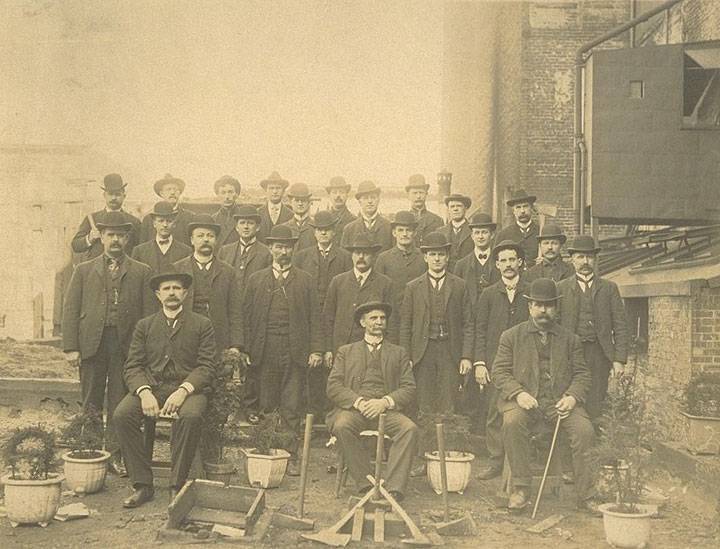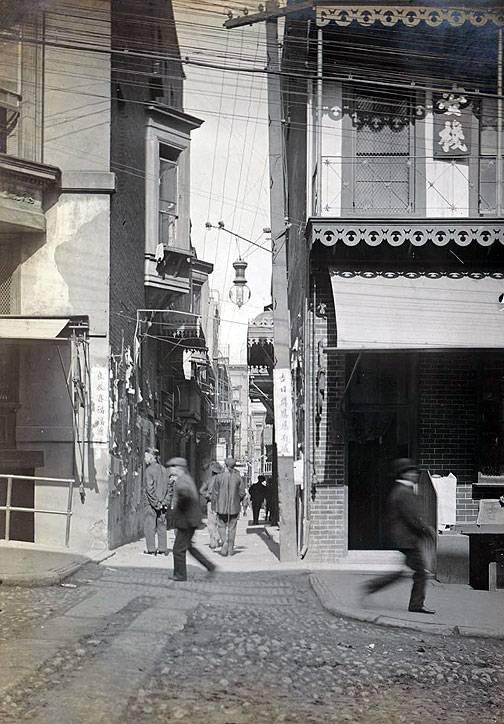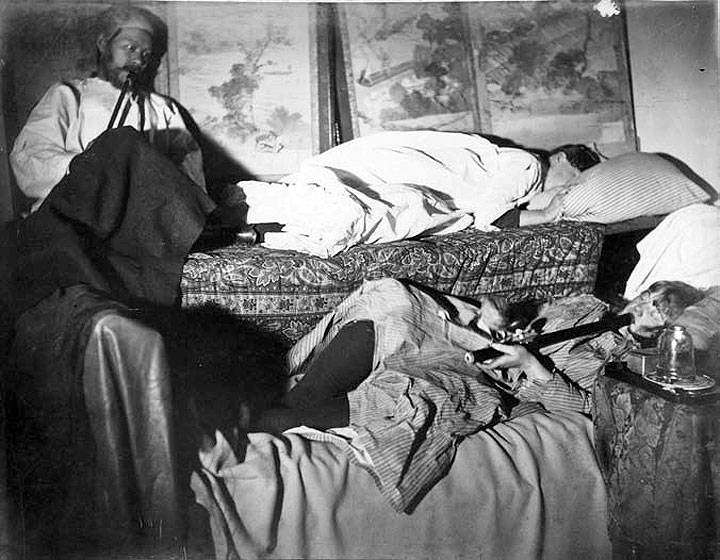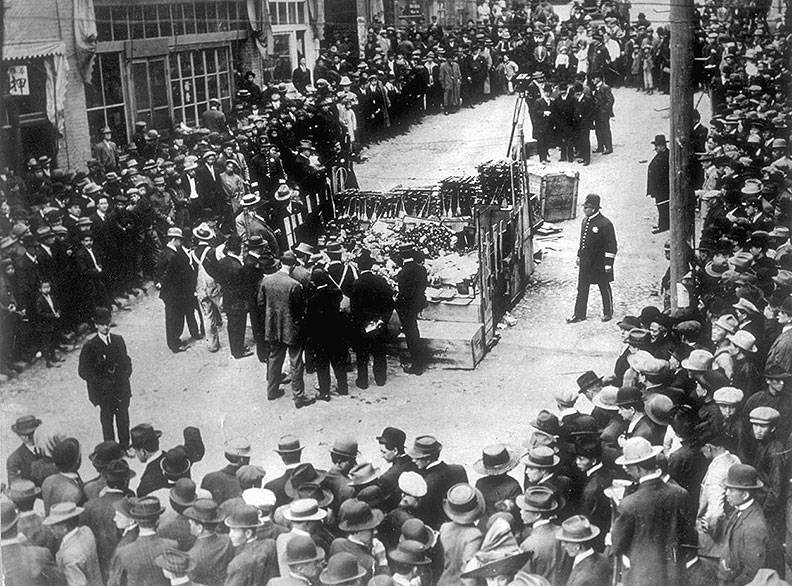Opium Dens in Chinatown
Historical Essay
by Barbara Berglund
The Chinatown Squad of the SF Police Department, 1905.
Photo: Jessie Cook collection, Online Archive of California, tf187006hd
Opium dens were undoubtedly the most sensational destinations on Chinatown's tourist terrain. While tourist literature's representations of them drew heavily on notions of a Chinese proclivity for vice, images of opium dens also suggested a kind of naughty deviance in that a visit put tourists in tempting proximity to a forbidden pleasure. Unlike restaurants, another arena of tourist consumption, in which visitors frequently recoiled—at least initially—at the food proffered, in opium dens it was the smokers who were disgusting, not the opium itself. Since the impulse to see Chinese opium smokers and their dens came from the desire to be both disgusted and tempted, such sights were simultaneously both repulsive and alluring to white middle-class sensibilities. On one level, representations of opium dens worked to differentiate the Chinese from white Americans. By virtue of the fact that tourist literature represented the Chinese as regular users of opium, it effectively configured them as lacking the kind of self-controls of mind and body that the nineteenth-century white middle class, in theory, was identified with and organized around. According to the Chronicle, for example, the "habit of opium smoking" was so prevalent among the Chinese that "the fumes of the insidious narcotic" poured forth throughout Chinatown "from basement and upper floor, from shop and office, from business house and private apartment." Yet while the idea that opium use set the Chinese apart was pervasive, on another level the tourist literature also revealed that it actually brought whites and Chinese together, both through the tourist enterprise and in their shared used of the drug.(52)
A desire to see the racially abject—the epitome of which was the opium smoker in his lair—compelled many tourists to seek out opium dens as part of their Chinatown excursion. Although E.G.H.'s guide, Chin Jun, claimed that the high number of people in her party prohibited him from taking them all to the dens, E.G.H. surmised that it actually had more to do with the fact that he "did not want to expose his countrymen" to their scrutiny. Given the fact that the kind of violent invasions commonly used by police guides were part and parcel of many opium den forays and given the way many tourists wrote about such experiences, Chin J un had every reason to be reticent. Descriptions of opium dens tended to be organized around depictions of Chinese viciousness as well as Chinatown's crowding and filthiness. Tourist literature instructed tourists in advance that a visit to an opium den would allow them to venture into and behold some of Chinatown's most repellent sights. According to B. E. Lloyd, while a visitor to Chinatown "may have had his senses shocked by the savage noises that are heard in passing through the reeking alleys and lanes," he would not have "seen the most disgusting characteristic of the Chinese 'quarter'" until he was "within a well patronized opium den, and recovered from the shock experienced upon first entering." Iza Hardy, like many other writers, described the opium den her police guide led her to as "unlit, unventilated, very like the steerage cabin of an emigrant steamer, equally evil-odorous."(53)
Typical alley in Chinatown, 1890s.
Photo: Bancroft Library
For many tourists, however, just taking in the scene at an opium den was not enough. They also wanted to observe the den's inhabitants smoking opium. Josephine Clifford wrote about a performance of opium-smoking that was encouraged by the strong-arm tactics of her police guide. Her guide "commanded" one of the denizens, "Hurry up… now we want to see you fill that pipe." This man, referred to generically as "John" replied "apologetically," "Opium no belly good ... but me fixem pipe." With that, Clifford explained, "he drew a fat little jar toward him, of paste-like content" and in "three or four whiffs" finished the pipeful. W H. Gleadell wrote of entering one opium den just as "a smoker was… commencing operations." He not only observed the method and ritual of opium smoking but also, in vivid detail, recorded the process for his readers. Gleadell related that the smoker, after "composing himself in a comfortable position on one of several couches… took up the long wooden pipe provided by the establishment and carefully examined it." Next, "taking up a long needle-like piece of steel" he "inserted it in the ivory box and drew therefrom a small quantity of prepared opium." Then, he "held this over the flame of the lamp"—because, as Gleadell explained, "the drug must be dried before it can be inhaled"—"carefully twisting and turning it about until the heat had frizzled it up." Iza Hardy related watching opium smokers "take a pinch of the dark jelly-like substance on a wire and melt it over the lamp, then smear it over the aperture in the pipe, and draw it with great deep breaths into the lungs."(54)
The intricate details of some of these descriptions suggest that they may have not only functioned as one component of the lurid construction of a vicious Chinatown but also as instructional devices for the most adventurous. The temptation to tourists was, at times, very real. W H. Gleadell reported that he not only began "to feel the effects of the opium-laden atmosphere" as he watched the performance of opium smoking that he so carefully recorded for his readers but that he and his companions were "very much pressed to try a pipe ourselves." They "unanimously declined," and Gleadell reflected that they were "deterred as much… by the fear of our surroundings as by the sight of the white, sickly faces and glassy eyes of the smokers around us." Eleanor Caldwell was also invited to smoke opium. Her Chinese guide, who may have been the same man she would later converse with about life and politics on a restaurant balcony, "twisted the opium on a little stick, burned it lovingly in a lamp, and depositing it in its receptacle at the side of the long wooden tube, smoked a few whiffs, as exemplification." When the pipe was passed in her direction, she and her companions did not decline. Instead they "carefully wiped the mouth, and each took an inhalation." Caldwell was well aware that her behavior was both transgressive and a little dangerous. She recalled that as she smoked, she saw "a Poe-like cat sitting on the edge of the shelf" who "curved his back, as though the devil were expressing sympathy."(55)
While some Chinatown tourists who trekked down to the opium dens received offers to partake of the drug, others prompted different reactions from the people they saw and interacted with there. Eleanor Caldwell, in addition to being offered a smoke, reported that the men she observed were "lying in a trance, curled up," some with their backs toward her. One responded to her presence by leaning up on his elbow and looking at her in what she called "a dead-and-alive way… vacant of any comprehension." When she came upon another group of smokers in yet another den, her presence engendered a more hostile response. She described these men as "unhumanized beings, lolling in pale and imbecile torpor, or glaringly, gauntly resentful." Charles Warren Stoddard recalled not getting as much of a response as he would have liked from the smokers he encountered. When he initially addressed them he was "smiled at by delirious eyes." But as the drug took effect the smokers' heads sank "upon the pillows" and they no longer responded to his appeals, "even by a glance." A writer for Cornhill Magazine, however, reported a much livelier and sociable scenario in the opium den he entered in order "to purchase a pipe and smoking outfit" for his "curiosity case." Before he "had been in the place two minutes not an inch of standing room was unoccupied" and "everyone who was able to speak any English volunteered advice and information" about what kind of pipe he should purchase.(56)
Chinese opium smokers clearly encountered more white tourists than they probably would have liked in the dens they frequented even if the displays of vice and depravity they presented were rewarded with money or drugs. Yet although tourist literature generally represented the typical opium smoker as Chinese and the typical white visitor as a tourist, a number also acknowledged that the Chinese were not the only opium smokers in Chinatown. Aside from the kind of incident in which Eleanor Caldwell and her friends each took a puff from an opium pipe, there were other white people, not tourists in the traditional sense, who frequented the dens. In many respects, because of the kind of social mixture and transgression of racial boundaries these white smokers represented, their activities far outweighed those of the Chinese in their scandalousness. Yet they too, in the ways they were written about and memorialized through photography, became part of Chinatown's tourist terrain. "White Women in Opium Den, Chinatown S.F.," one of the many photographs I. W. Taber produced for tourist consumption, depicted two white women—one smoking, the other asleep or unconscious—in the company of a leering Asian man. Although probably staged, this image mobilized notions of Chinatown's sexual danger prevalent in contemporary novels and short stories and powerfully activated imaginings of the licentiousness that could afflict young white women compromised by drugs.(57)
White women in opium den. This image, probably staged, plays on wide spread fears of Chinatown as a vicious place of sexual danger for white women, especially when combined with drug use.
Photo: I.W. Taber, photographer. Chinese in California, Bancroft Library, University of California, Berkeley
B. E. Lloyd explained to readers of his guide that "in some of the more secluded opium dens, and those kept under strict privacy by the proprietors," one would "find a number of young men and women—not Chinese—distributed about the room on lounges and beds in miscellaneous confusion, all under the influence of the drug." According to Lloyd, most of the women were of "the disreputable class," but the young men were "our respectable sons and brothers, who move in good society, and are of 'good repute.'" E. W. Wood, another San Franciscan "acquainted with the ins and outs" of Chinatown, testified that he discovered both "the sons and daughters of the wealthiest and most refined families… laying on the filthiest covered bunks along side of cracked and broken layouts, smoking and sleeping their lives away." An article in the Chronicle claimed, however, that the "most serious phase of the opium habit" in the city was the hold it had secured "upon the lower and more depraved classes of whites"—suggesting, when placed alongside the accounts of Lloyd and Wood, that opium use was a pastime that crossed class lines. As J. Connor Torrey sensationally put it, "Five thousand white slaves to the oriental drug in San Francisco, and the majority own to having taken the initial whiff in 'Chinatown.'"(58)
For whites interested in ingesting opium, neither finding the drug nor a place to consume it was particularly difficult. The enforcement of laws prohibiting "public opium-houses" was lax at best and private smoking among the Chinese was common enough that white guests in Chinese homes or businesses—or white tourists, like Eleanor Caldwell, in an opium den—were frequently invited to smoke. A story in the Chronicle that noted many of Chinatown's opium dens "were in the habit of providing the pipe for white people" was confirmed by one white visitor who, upon entering two different dens, was asked, "You wanchee smokee?" In one resort, this visitor "drew the fellow on so far as to induce him to bring a pipe and prepare to weigh 25 cents' worth of opium." The writer of this account also reported witnessing "an earthen-faced and haggard-looking young white man" approach "the basement of Wing Bing, 746 Commercial street" where there was "a great flaming advertisement in Chinese calling attention to the place as a smoking resort." The young man "cast furtive glances on each side and then dashed down the steps." As one young woman, an actress and opium user, purportedly put it, "Then someone suggests a trip to Chinatown, and the opium-house obtains another customer. That's the way I drifted into them, and I must confess, I am not sorry for it either. It's a deal better than whiskey, and I had my choice of one or the other." If an interested party was not keen on visiting an opium den, a number of accounts pointed out that it was neither uncommon for retail stores in Chinatown to sell opium nor "to see young men and women stealing into Chinatown at night, entering an opium shop, and procuring half a dollar's worth of the lethal drug." Making it even easier was the fact that accounts in the San Francisco press that at some level were meant to function as exposes published huge lists of the names and addresses of both dens and retail outlets.(59)
Authors of Chinatown literature, in tandem with the practices of Chinatown guides, deftly charted paths that facilitated the navigation of Chinatown's tourist terrain in ways that linked a visitor's experience of this cultural frontier to an understanding of the Chinese as filthy, unassimilable, vicious, and barbaric. They also often ventured a step further and used their depictions as vehicles for articulating the morality and merits of the most pressing social issue that pertained to their work: the "Chinese Question." Throughout the second half of the nineteenth century, Chinese immigration was a hotly debated issue in San Francisco and beyond. The vast majority of the time, authors of Chinatown tourist literature answered the "Chinese Question" in the negative. The not so subtle subtext of their arguments generally centered on whether or not Chinese immigrants were compatible with the American body politic and revolved around issues of assimilability, public health, labor competition, and vice-the same themes that were used to construct the "Oriental" in the popular imagination and which pervaded analyses of tourist sites. The author of an article that ran in Scribner's put it bluntly but typically, mobilizing themes of unassimilability and social pollution. ""While immigration is the life-blood of young nations," this writer explained, "there is such a thing as blood-poisoning, and this is frequently occasioned by the presence of some foreign substance." In this writer's opinion, "John" was "that substance" because he was "utterly devoid of any quality of assimilation." A journalist who penned an article in Outing expressed his hostility to Chinese immigration through his articulation of what had become widely held beliefs about the threats the Chinese posed to free white labor. He explained, "The Chinese, with their great cunning, oust American labor. They work at what would be starving wages to a white man, for a few years, then leave for home with their hoarded earnings." Expressing his fears about the risks Chinatown and Chinese immigrants posed to public health,]. Torrey Connor warned that "when smallpox and other infectious diseases that germinate in the filth of that malodorous quarter are raging, then, indeed do we come to a full realization of the undesirability of our Mongolian neighbors." Summing up tourist literature's overall sentiments, he added, "Unlike other foreigners who come to our shores, the material from which 'good citizens' are made is not to be found in this alien race."(60)
Burning opium and opium pipes on Dupost Street between Clay and Washington by U.S. marshals, c. 1900.
Photo: Online Archive of California
Notes
52. See Lee, Orientals, 124 San Francisco Chronicle, February 18, 1894.
53. Lloyd, Lights and Shades in San Francisco, 260-261, and Hardy, "In Chinatown, 217. See also, Ames, "Day in Chinatown," 500; Keeler, San Francisco and Thereabout, 65; Gleadell, "Night Scenes in Chinatown," 38I-382; Clifford, "Chinatown," 355; "Lenz's World Tour," 362; Browne, Trip to California, 104-105; Stoddard, Bit of Old China, 11; and Caldwell, "Picturesque in Chinatown," 660-661.
54. Clifford, "Chinatown," 355; Gleadell, "Night Scenes in Chinatown," 381-382; and Hardy, "In Chinatown," 217. For similar descriptions, see also Carey, By the Golden Gate, 173-179; Ames, "Day in Chinatown," 500; Stoddard, Bit of Old China, 11; Morris, Pacific Coast Vacation, 176; and E.G.H., Surprise Land, 99.
55. Gleadell, "Night Scenes in Chinatown," 381-382, and Caldwell, "Picturesque in Chinatown," 661.
56. Caldwell, "Picturesque in Chinatown," 661; Stoddard, Bit of Old China, 12; and" 'China Town' in San Francisco," 52-53.
57. I. W. Taber, "White Women in Opium Den, Chinatown S.F," Copyrighted by I. W Taber, May 31, 1892.
58. Lloyd, Lights and Shades, 262; E. W. Wood, Life and Experience of Prof E. W Wood Appertaining to the Opium Habit of the Chinese (New York: Dick's Publishing House, 18-), npn; and Connor, "Western View of the Chinese," 378. See also Carey, By the Golden Gate, 179.
•
59. For the illegality of opium smoking in public but not private in San Francisco, see San Francisco Chronicle, February 15, 1894, and C. P. Holden, "The Opium Industry in America," Scientific American 77,no. 10 (March 5, 1898): 147. For the common use of opium among the Chinese, see San Francisco Chronicle, February 15 and 19, 1894. San Francisco Chronicle, February 15, 1894; "Hitting the Pipe," National Police Gazette 38, no. 204 (August 20, 1881): 6; San Francisco Chronicle, February 19, 1894.
6o. John Chinaman in San Francisco," Scribmer'sMonthly 17, no. 6 (October 1876): 871; "Lenz's World Tour," 363; and Connor, "Western View of the Chinese," 375• See also Lloyd, Lights and Shades, 213-217; Gleadell, "Night Scenes in Chinatown," 378; Densmore, Chinese in California, 1, 117; "The Chinese at Home and Abroad," Hutchings' Illustrated California Magazine, 5 (1860-1861) 324-330; Fitch, "City by the Golden Gate," 659-668; Baldwin, "Celestial Colony," 128-129; Hardy, "In Chinatown," 226; Holbrook, "Chinadom in California," 129-132, 173-178; Bancroft's Tourist Guide, 217; and Craft, "Some Days and Nights in Little China," 100, 109.
Originally published in chapter 3 “Making Race in the City: Chinatown's Tourist Terrain” in Making San Francisco American: Cultural Frontiers in the Urban West, 1846-1906 by Barbara Berglund (University Press of Kansas: Lawrence KS 2007)





